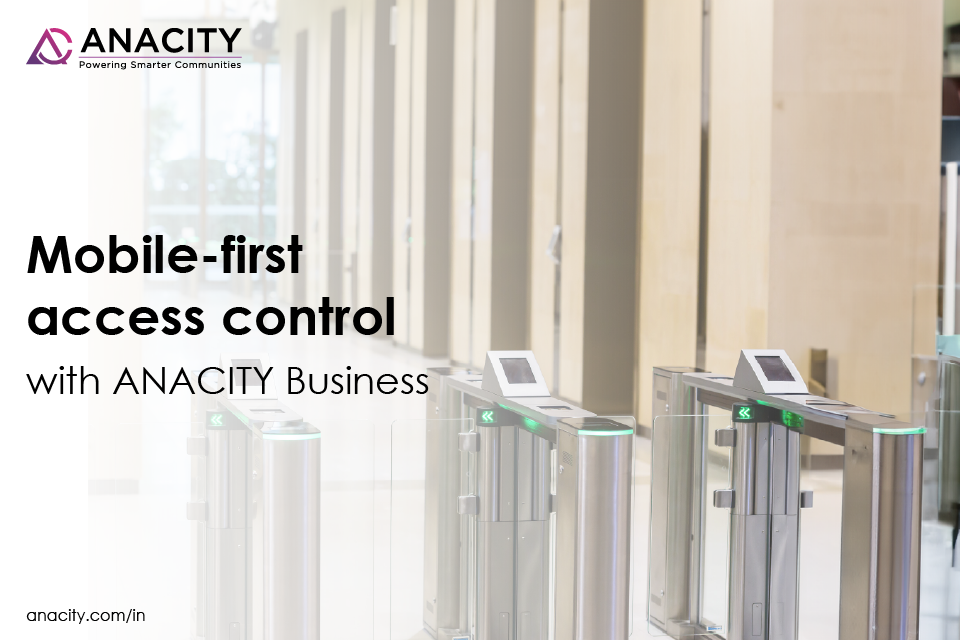Why Mobile-First Access Control is the Future of Workplace Security
Product News smart workplace, smartphones, workplace automation, workplace community management, workplace management, workplace safety, workplace securityThe next time you swipe your access card at your office turnstile may be your last. With the rise of embedded technology, Commercial Real Estate (CRE) leaders are rapidly switching to mobile-first access control. Besides convenience, these smart security solutions are also more efficient, cost-effective, and sustainable.
Smart access control by ANACITY Business leverages mobile-first technology to replace legacy systems of access cards and manual entry logs. The SaaS platform, designed to digitally transform commercial workplaces, strengthens security while ensuring convenience and a tech-first approach.
Rise of the mobile-first access control
A recent research by the Economist Intelligence Unit established a measurable link between more mobile-first working environments and an increase in employee engagement. Companies that were rated as “pioneers” in their support for mobile technology saw a rise in productivity (16%), creativity (18%), satisfaction (23%), and loyalty (21%) when compared to organisations that were rated as poor in supporting mobile technology.
Consequently, CRE leaders are now switching to mobile-first workplace, particularly in access control. Many commercial workplaces still utilise access cards or key fobs creating an unnecessary bottleneck. These traditional access control mechanisms are also less secure than digital modes.
What is mobile-first access control?
Mobile-based access control replaces the traditional access cards and key fobs with mobiles. It leverages cloud, wireless, and smartphone tech to digitalise gate management. The system connects the employee, staff, or visitor’s smartphone with the turnstile reader to authenticate the user’s identity.
Coupled with ANACITY’s digital Visitor Management system, it creates an additional layer of robust and foolproof security. Read more in our article, Smart Security Systems: How ANACITY Business Makes your Workplace Safe & Secure.
Benefits of mobile-first access control
Mobile-based access control offers multiple benefits, including:
Enhancing security: Lost and stolen cards and key fobs pose a security threat. Very often the missing card is not noticed till the last minute. This creates a major security risk for the workplace where unauthorised visits can remain undetected. A digital access control system is harder to tamper with since a missing phone is likely to be noticed instantly. Moreover, access will also involve bypassing the phone’s security.
Ease of access: India has 1.2 billion mobile phone users with 600 million using smartphones. The average office-goer and visitor is, hence, likely to use mobile phones as a default. Today, the average person rarely steps out of his/her home without their phone. With mobile-first access control, they don’t have to carry any additional access devices.
Reducing human intervention: Legacy systems often require human intervention at the turnstile or gate. Even with access cards, walk-in visitors require the lobby staff’s assistance to enter. In contrast, mobile-first access control removes human intervention since access depends completely on mobile scans. Reduced manual intervention also ensures contactless entries.
Automated digital reporting: Every entry is logged in automatically at the point of entry. This digital system is free from human errors and is tamper-proof. It also ensures that all entries are recorded without fail.
Real-time reports: Digital systems facilitate data analytics with easy access to real-time reports. Gain quick insight for efficient monitoring and identify security oversight. It gives us an accurate picture of the occupation status in a building – who’s on-site, when, and how often. This data facilitates decision making such as identifying peak times that require additional security staff.
Role-based access: ANACITY’s mobile-first access control system can be enhanced to facilitate role-based entries. It acts as digital cordoning off of specified areas. It can thus be leveraged to automatically restrict unauthorised access.
Emergency preparedness: Property teams can partially or completely shut down all access in an emergency. For instance, lifts can be halted during a fire emergency. Similarly, access can be restricted to any area that is deemed dangerous. The system imposes these controls automatically, removing any chances of manual errors or oversight.
